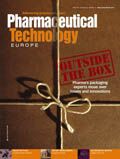Improving Packaging Security
Pharmaceutical Technology Europe
Legislation has prompted the pharma industry to seek technologies that can be used to secure a product throughout the supply chain.
Editor's note: This article is part of a special feature on packaging that was published in the May issue of PTE Digital.
Legislation has prompted the pharma industry to seek technologies that can be used alone or in combination to secure a product throughout the supply chain. Some markets, including France, Italy and Turkey, have specific guidelines about identification solutions that must be applied to packaging to help solve counterfeiting and reimbursement challenges.
Chris Halling, EU product manager at Catalent Pharma Solutions.

In February this year, members of the European Parliament approved a new law to help prevent fake medicines from entering the supply chain by mandating the use of technologies that enable pharmacists and patients to check whether the outer packaging has been tampered with. One solution could be to include a serialisation number that can be 'read' by the pharmacy to ascertain whether the pack is authentic. The European Parliament has also recognised that outer packaging needs to be made secure with tamper-evident labelling or similar measures. In this respect, a combination of overt and covert measures may provide optimal security because they help prevent counterfeiting and reassure end-users. For example, the packaging could use a holographic label containing a random code that is repeated in the serialisation number or even on the tablet or medication itself.
Currently available solutions vary from the straightforward application of labels to far more complex solutions, such as serialisation, which requires a significant supporting infrastructure to gather data at various points of the supply chain. To protect a product, it is important to use a multilevel approach that combats the counterfeiters at as many stages of the supply chain as possible.
Serialisation is certainly one of the most discussed anti-counterfeiting solutions. If it is implemented effectively then it could be possible for a patient to verify the authenticity of their medication from their mobile phone. As well as helping to secure supply chains, serialisation also offers the benefits of real-time visibility, and precise data on inventory balances, production status and other key project information across the production lifecycle. The main challenges of implementing serialisation, on the other hand, are the complexity of data that needs to be captured and tracked, and the requirement for potentially huge, multi-access databases.
Anti-counterfeiting measures can also be incorporated through the medication itself by using intellectual property or a specific feature that is recognisable to the patient, such as a distinctive mouth feel, that makes a medicine difficult to imitate. If you can't make it, then you can't copy it!
Packaging selection often takes place late in development programmes and cost is a key factor. If the purchasing team are not fully briefed on the adverse impact of counterfeits, then they will view any cost increases to counter this risk as unnecessary. Another risk in the implementation of anti-counterfeiting technology is that the chosen technology may be replaced if the industry veers towards a different solution. As such, for the moment at least, there is reluctance to commit to any specific coding or marking technology until regulation makes it essential.

Drug Solutions Podcast: A Closer Look at mRNA in Oncology and Vaccines
April 30th 2024In this episode fo the Drug Solutions Podcast, etherna’s vice-president of Technology and Innovation, Stefaan De Koker, discusses the merits and challenges of using mRNA as the foundation for therapeutics in oncology as well as for vaccines.